Home / Blog / Fundamentals / Keyword Clustering: Probably The Best Guide You’ll Ever Read
Keyword Clustering: Probably The Best Guide You’ll Ever Read

Mar 7, 2024
Share to
A lot is being written about content clusters lately and with good reason. Creating content by focussing on “clusters of keywords” works. Check out the organic uplift to just the blog section of this competitive niche in 6 months:
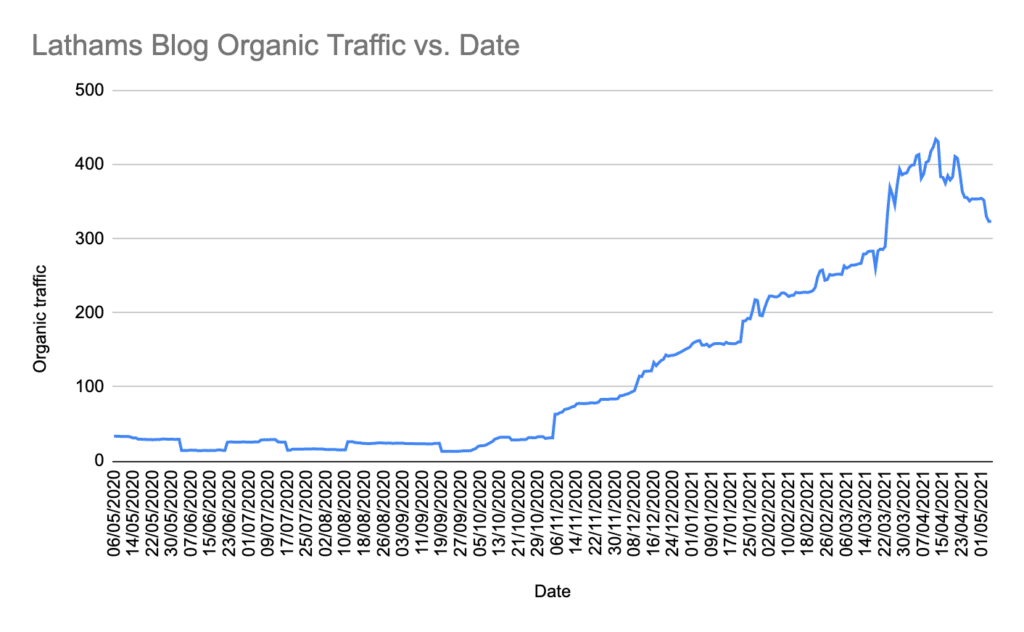
That represents, roughly, a 1,250% increase in traffic!
In this guide, we’ll demystify the concept of keyword clustering, a powerful content marketing technique that can significantly boost your website’s organic visibility. We’ll walk you through the process step-by-step, making it easy to understand and implement.
Let’s dive in and start exploring the exciting world of keyword clustering!
A Short Introduction to Keyword Clustering
In the realm of Search Engine Optimization and content marketing, a key strategy for content planning and content creation is keyword clustering. This innovative technique can significantly upgrade the efficacy of your SEO campaigns and help you plan and write your content more efficiently and with greater effect.
What Is Keyword Clustering?
“Keyword clustering” is where related keywords from your keyword research group are collated into groups of similar keywords. This strategic process is designed to enhance website visibility on search engines by streamlining the optimization of a single webpage for a cluster of similar keywords, as opposed to just one keyword. Observing this practice improves the relevance of the website, which can contribute to a higher ranking on search engine results pages.
Picture this scenario. You have just completed keyword research on the topic of “dining tables”. You’ve amassed a considerable list of over 10,000 keywords. The task of individually analyzing all 10,000 keywords might seem overwhelming. But, here’s where the magic of keyword clustering comes into play.
The Clustering Solution
With keyword clustering, you can group those similar terms together. You may soon find, with some surprise, that your colossal list of 10,000 keywords could actually be accommodated on just 300 pages. Why? Because many of the keywords share the same meaning. It’s this technique of grouping and targeting similar keywords that define “keyword clustering”.
For example, in the screenshot below you’ll see 7 keywords (from a list I had about of 10,000) that are grouped because they mean the same thing.

Benefits of Keyword Clustering
- Improved SEO Ranking: By grouping keywords, you can create more comprehensive and topic-specific content. This can improve your website’s ranking on search engines as your content will more thoroughly answer user queries.
- Enhanced User Experience: Keyword clustering can help you create more valuable content for your users. By covering a topic extensively, you can effectively meet your site visitors’ various needs or queries, enhancing their browsing experience.
- Easier Content Creation: Creating a significant content volume around a single keyword can be challenging. With keyword clustering, you have numerous related keywords to focus on, making generating unique and relevant content easier.
- Better Site Structure: Keyword clustering promotes a more organized site structure, making it more user-friendly. Each cluster can become a new category or subcategory on your site, directing users to the content they are interested in and improving navigation. You can also group similar clusters together to form what we call “topic clusters” which are covered a little later in this guide.
Types of Keyword Clustering: SERP Clustering vs Semantic Clustering
There are actually two main types of keyword clustering:
Semantic Clustering
Semantic keyword clustering with NLP involves the grouping of keywords based on their semantic similarity, meaning how closely their meanings relate to each other. NLP, a subfield of artificial intelligence, deals with the interaction between computers and human language. It assists in understanding, interpreting, and generating human language in a valuable way.
When applied in keyword clustering, NLP tools interpret, analyze, and relate the meanings of different keywords to each other. This allows SEO analysts to group similar keywords, based on their semantic connections, forming keyword clusters that revolve around the same core concept.
SERP Clustering
On the other hand, keyword clustering based on SERP results involves grouping keywords that bring similar URLs in the search results. The idea is that if certain keywords often appear together in SERPs, they likely have a close connection and should be targeted together in a single piece of content.
This approach relies heavily on the search engine’s interpretation of the connectivity of keywords, as manifested in its search results.
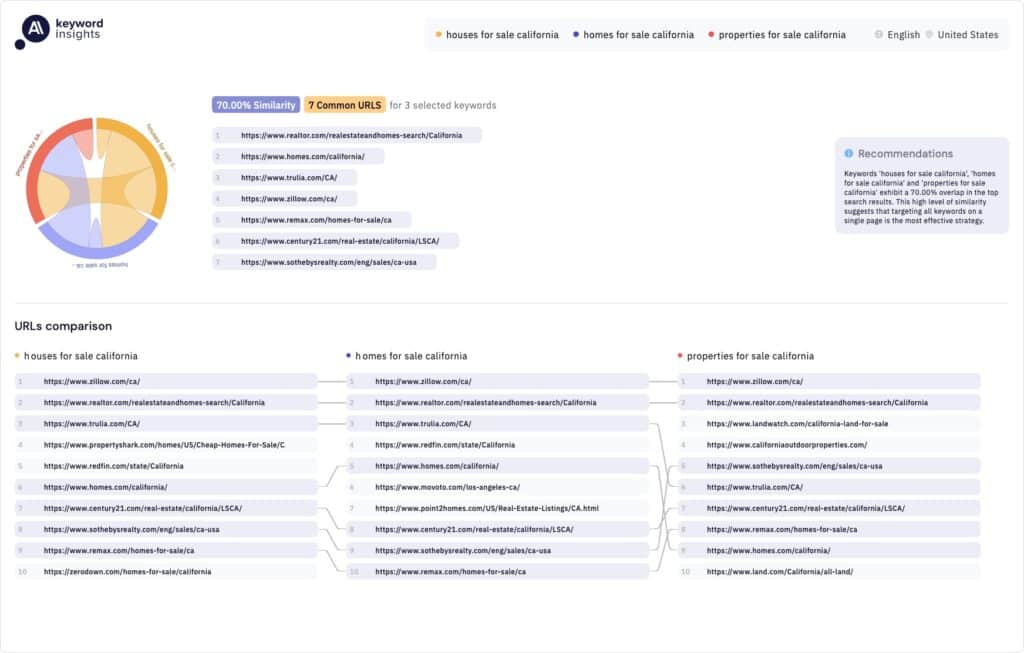
In short, semantic keyword clustering using NLP focuses on understanding and interpreting the inherent meanings and connections between keywords. In contrast, keyword clustering based on SERP results bases the connections on the pairing of keywords in search engine results.
Of course, both come with their pros and cons.
Pros and Cons of Semantic Clustering
The main pros of semantic clustering are:
- It’s usually cheap or free. There are plenty of Python scripts online that you can use for free to use NLP libraries that will group words based on how similar they are in meaning.
- Another pro is that the results can sometimes be less confusing to look at than if you used a SERP-based clustering program (something I’ll explain in the section below).
The biggest con, and it is a big con, is:
- We operate in Google’s world. If we want to create content to get visitors to our site, we don’t “miss” creating any pages. Semantic clustering often groups seemingly similar keywords, yet search engines might display markedly different results for each. This discrepancy indicates the possibility of missing out on creating a broader range of content that could address various search intents more effectively.
Consider this example. Most Vaping websites have a single page targeting “Vaporizer parts” and “Vaporizer accessories”. This makes sense. They mean the same thing right? Depending on the exact settings, most NLP-based clustering programs would also group these two terms as they are, semantically, very similar.
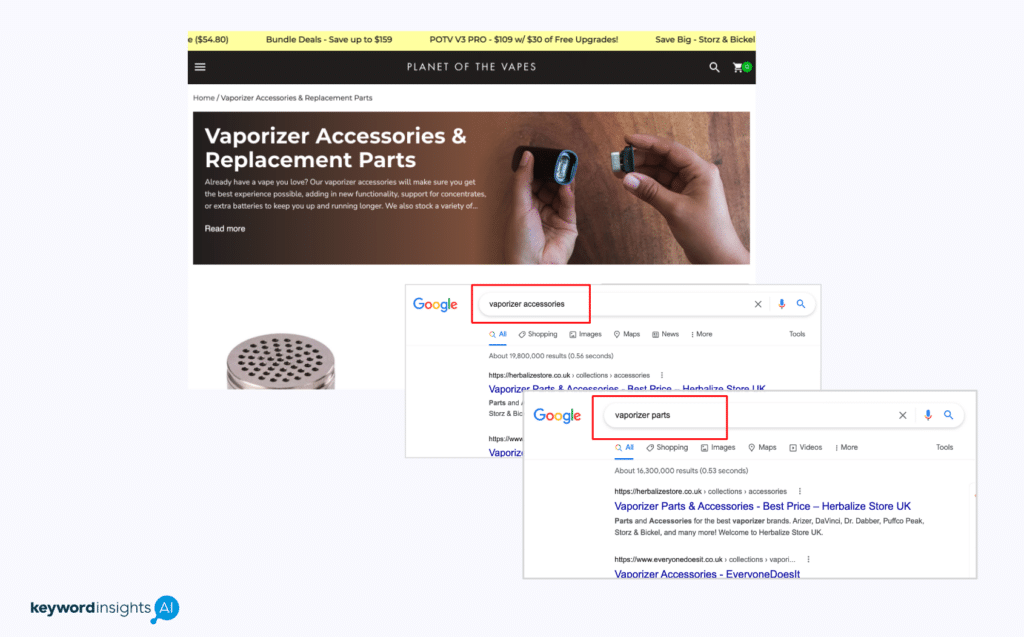
And yet we can see, using a SERP-based clustering program, the results are very different (in fact there’s only an 11.8% similarity). So, for this client (and most other Vape websites), we’d recommend creating 2 separate pages to target these two, high volume queries if we want to be visible for both.
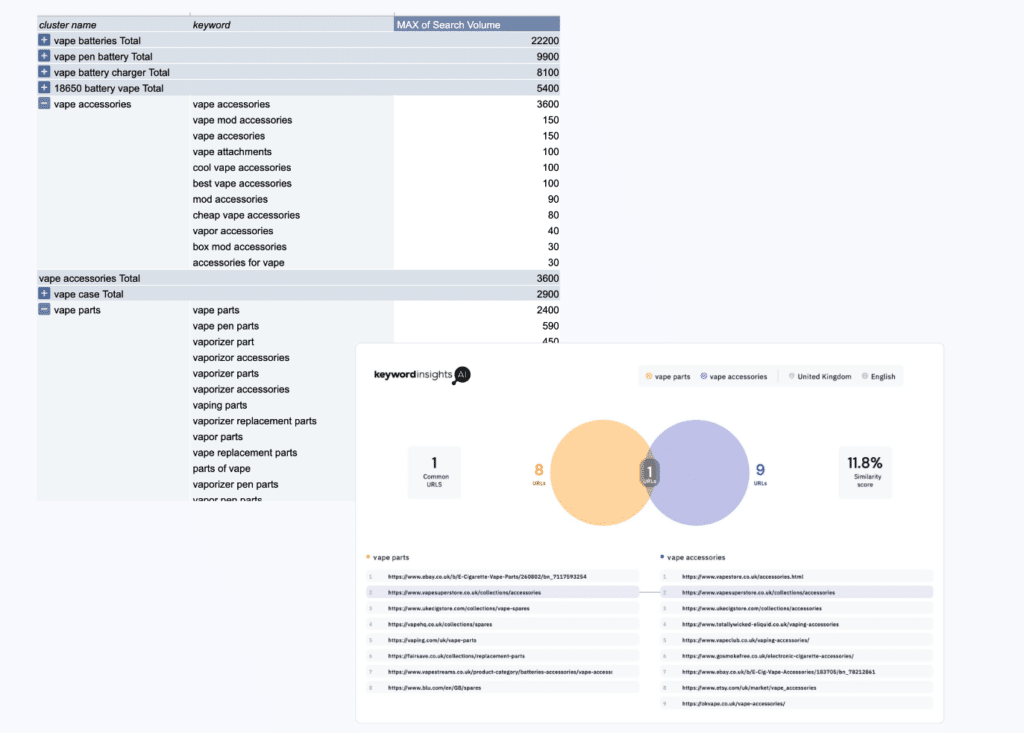
Pros and Cons of SERP Clustering
The main pro of SERP-based clustering is:
- We operate in Google’s world. Of course, this point is just the inverse of that mentioned above. To maximize our site’s visibility across a broad range of queries, our optimization strategy must align with search engine outputs. Search engines may display varied results for similar queries due to experimentation, errors, or nuanced differences understood through their algorithms, which analyze user feedback. For instance, the difference between “skateboard wheel” and “skateboard wheels” reveals distinct search intents: the former leans towards technical details, while the latter is more about purchasing. This highlights how minor keyword variations can significantly alter the perceived intent.
The biggest cons:
- It will always cost something. Scraping isn’t free.
- The results can be confusing. SERP clustering can sometimes result in something I call “keyword cluster fragmentation”. Keyword cluster fragmentation is when 2 or more clusters seem similar and would not require a separate page to target them. There is a video at the bottom of this page explaining “keyword cluster fragmentation” in more detail. Skip to just the 6 min 30 second bit and it’s explained in about 2 minutes.
Because of the huge benefits SERP clustering brings, Keyword Insights was built as a SERP-based clustering tool.
How to Do Keyword Clustering (SERP Based)
Using Keyword Insights’ clustering tool, you can cluster up to 2.5 million keywords fast.
Step 1: Begin by compiling a list of keywords.
Utilize the Keyword Discovery Feature from Keyword Insights for your research, or opt for alternative tools like Ahrefs or Semrush.
When conducting keyword research, my approach is quite broad. For example, if I’m researching keywords related to “CBD,” I typically input “CBD” into a keyword research tool and extract every keyword available. I avoid using filters initially. This method is much faster because it allows me to quickly categorize entire clusters of keywords as irrelevant after grouping them, rather than painstakingly applying multiple filters to eliminate them one by one.
Once you have your list (or lists) of keywords, proceed to use the keyword clustering feature available in the workflow or through the slide-out panel. If you have multiple different CSVs, we make it super easy for you to upload all of them at once without any formatting as you’ll see in step 3.
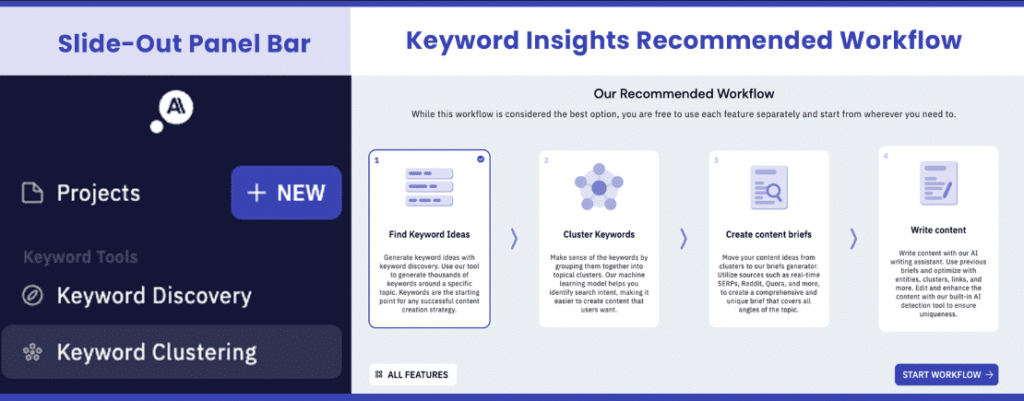
Step 2: Enter your project details.
This process is designed to be straightforward, with explanatory tooltips available for assistance whenever necessary.
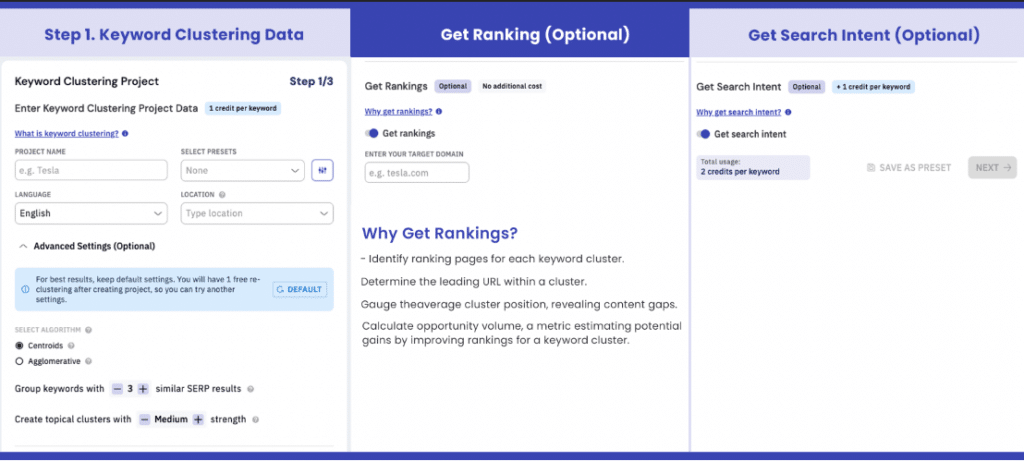
- Project Name: Select a name that accurately represents your project.
- Location: Specify the location (at the city or country level) where you wish to analyze SERP (Search Engine Results Pages) results.
- Language: Select the language you are targeting. We support all languages.
- Advanced Settings: Keyword Insights provides highly detailed clustering settings that can be tailored to your niche and requirements. You can adjust the clustering algorithm (which you can read more about here), the accuracy of keyword grouping (which you can read more about here), and the strength of topical clustering (which you can read more about here). For most cases, though, we recommend sticking with the default settings.
- Get Rankings: This is optional and with no additional cost. We recommend using it as it will gather your current rank and the ranking URL for each cluster, enabling you to quickly identify content gaps by spotting clusters with low or no rankings.
- Get Search Intent: This is optional and will 1 additional credit per keyword. We recommend using the “Get Search Intent” feature because it enables the discernment of each keyword’s intent through clustering. This approach simplifies identifying the appropriate content for each cluster and reveals clusters with diverse intents. For every keyword in a cluster, its specific intent and the cluster’s average intent are displayed. Plus, you can filter keywords/clusters based on the intent.
Step 3: Upload your CSVs and map the keyword and search volume columns for analysis
As previously mentioned, our platform simplifies the process of uploading multiple CSV files from various sources. There’s no need for you to manually open each file, merge them, align the columns, ensure the column names match, or worry about duplicates. The only requirement for each file is to have at least two columns: one for the keyword and another for the search volume. We’ll ask you to map these after you’ve uploaded them.
If your data lacks search volume (for instance, if you’ve utilized a tool like Also Asked), add a column and assign an arbitrary number to all entries.
You’ll notice in the screenshot below the Keyword and search volume columns from an Ahrefs file and Semrush file are completely different, but I’ve mapped the columns which I want it to take into account. The platform has also automatically detected the duplicates and removed them.
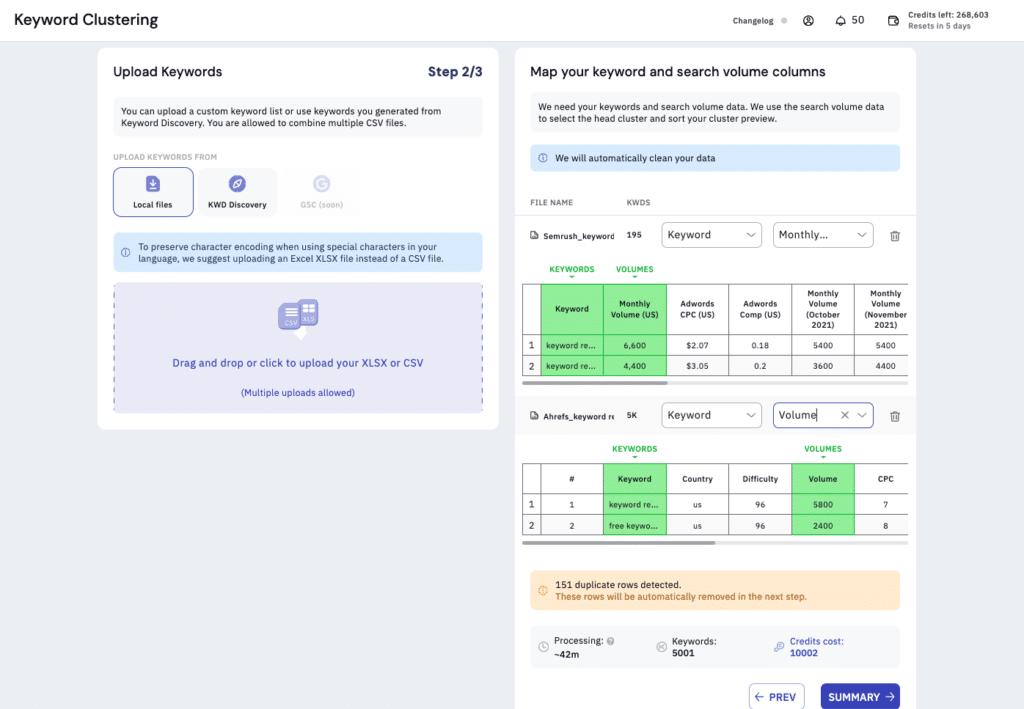
You’re also able to easily add any keyword you may have pulled from our own Keyword Discovery feature.
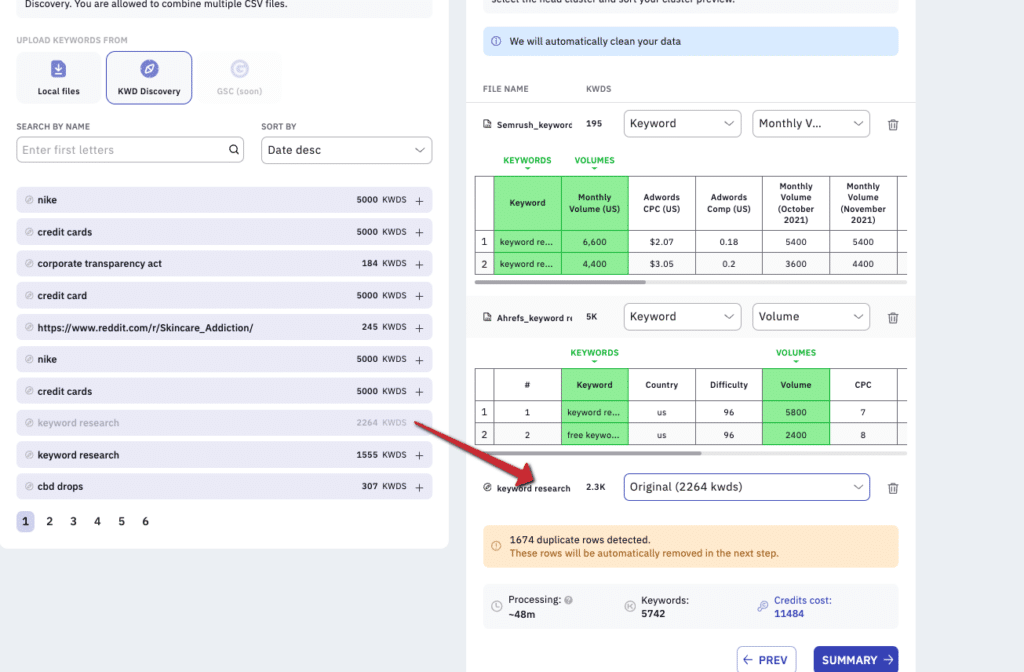
Once all your keywords are uploaded, click “summary” and let the tool do its thing.
Step 4: Analyse your data
Once the tool has finished running you’ll get a little email with your report.
You can view the results in Google Sheets (where we’ve already made the pivot table for you).
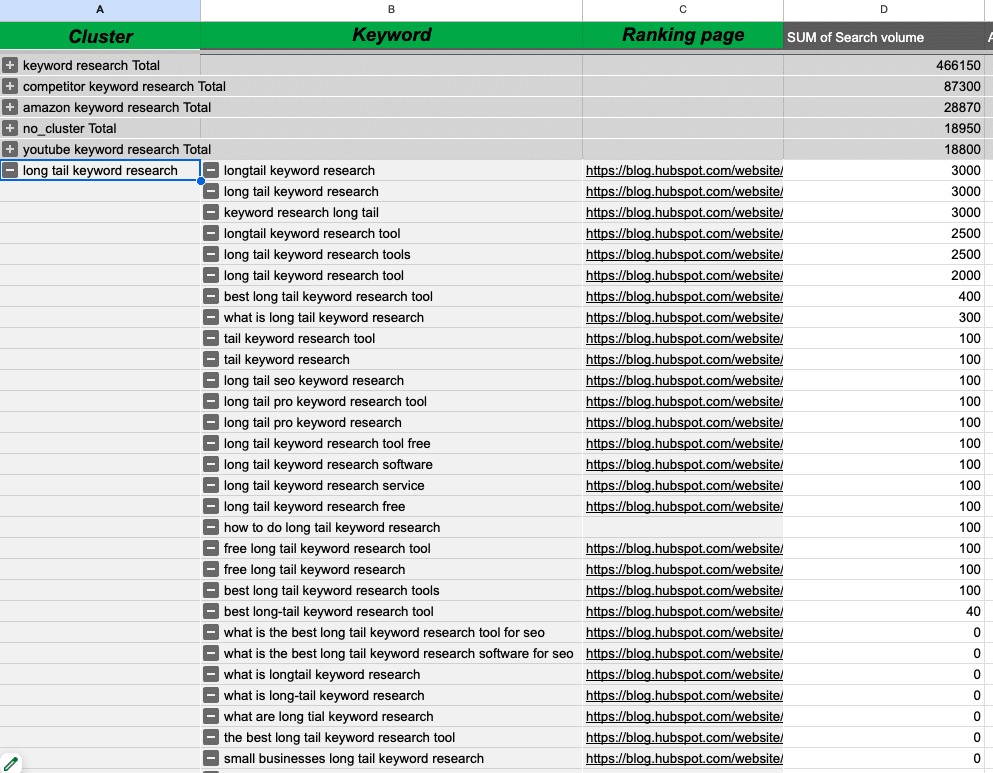
Or you can view it within the UI itself.
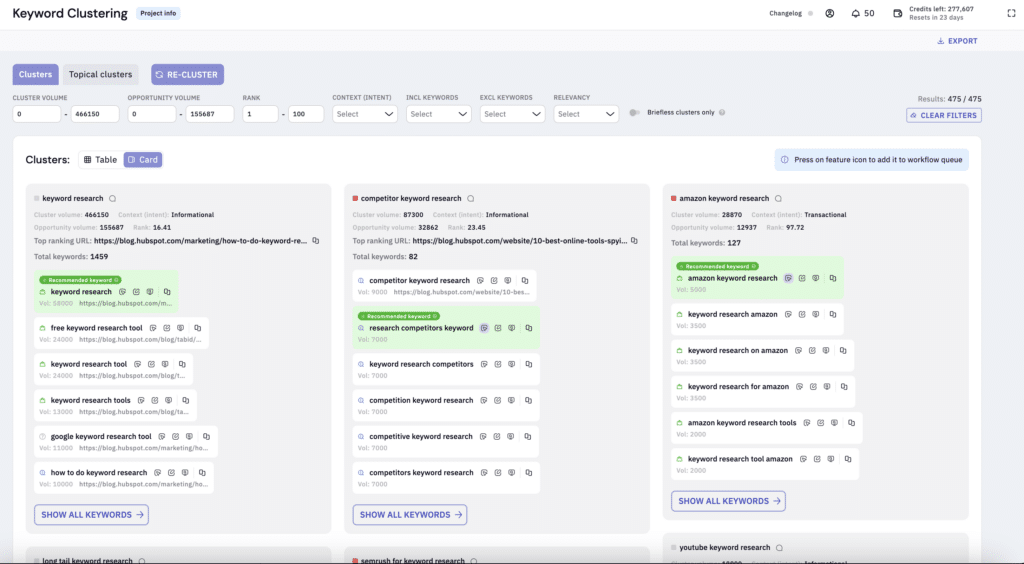
No matter how you choose to view your keyword clusters, be it in Google Sheets or directly within the user interface, you’ll notice that the tool has conveniently grouped all similar keywords together. This provides a wealth of actionable information, which we’ll dive into shortly. But, for instance, if you had opted for the ‘get intent’ and ‘get ranking’ options in Step 2, it’s a breeze to slap on a filter and spot all keyword clusters for which you lack content.
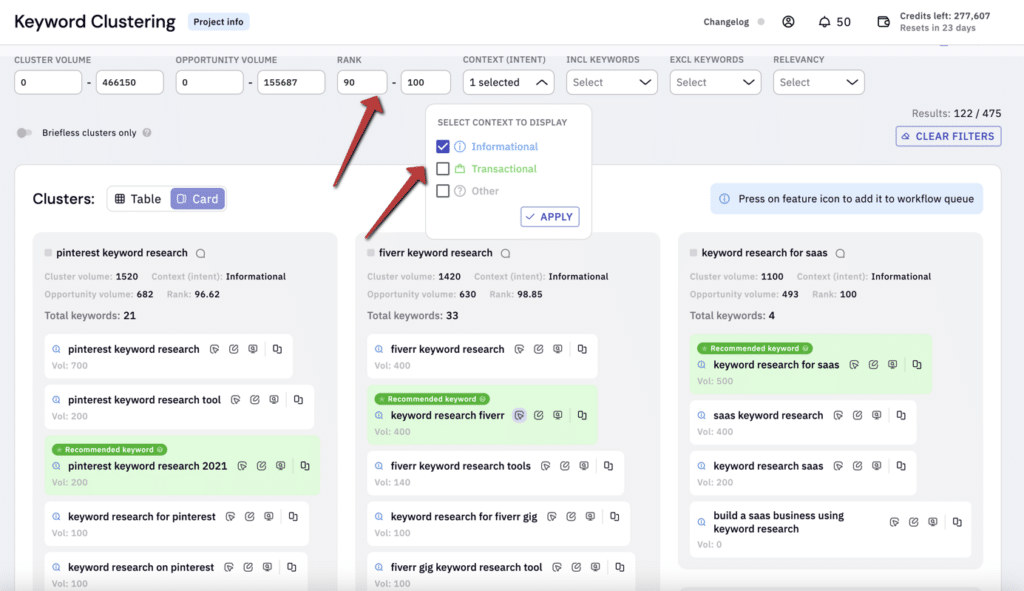
As you can see in the screenshot, I’ve added a filter to only show me the informational clusters for which my target domain doesn’t really rank. Voila, here are my content gaps!
Step 5: Write Your Content
As a bonus, Keyword Insights then makes it super easy for you to turn keyword clusters into content briefs (or even fully written content pieces) by clicking one of the buttons here and sending it to our content brief editor or AI writer.
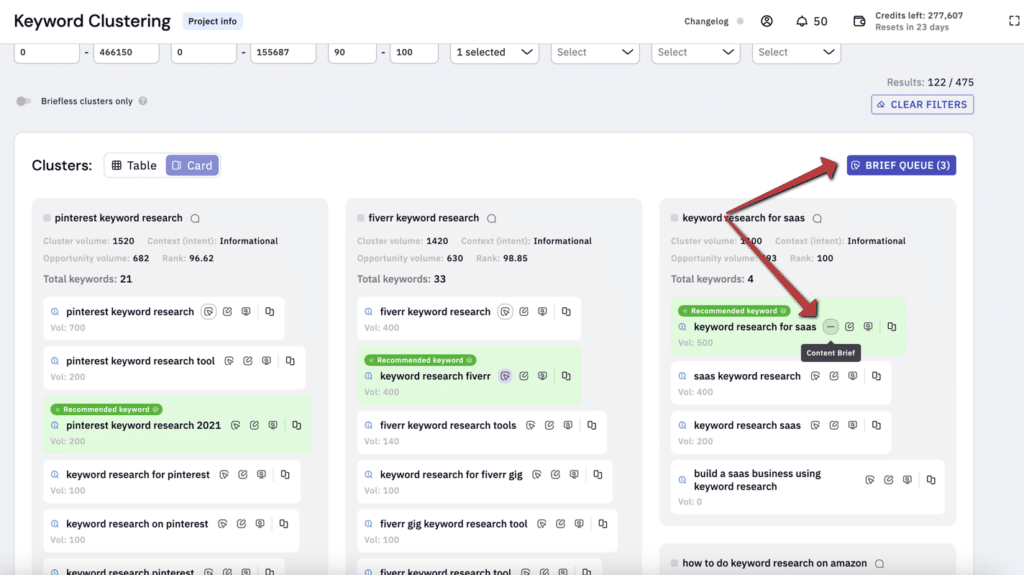
These modules allow you to quickly generate a complete outline of the article in under 60 seconds. Unlike other AI writers, we analyse live Search Engine Result data and conduct topic analysis to come up with the outline; it’s not just based on what an algorithm thinks should be the outline.
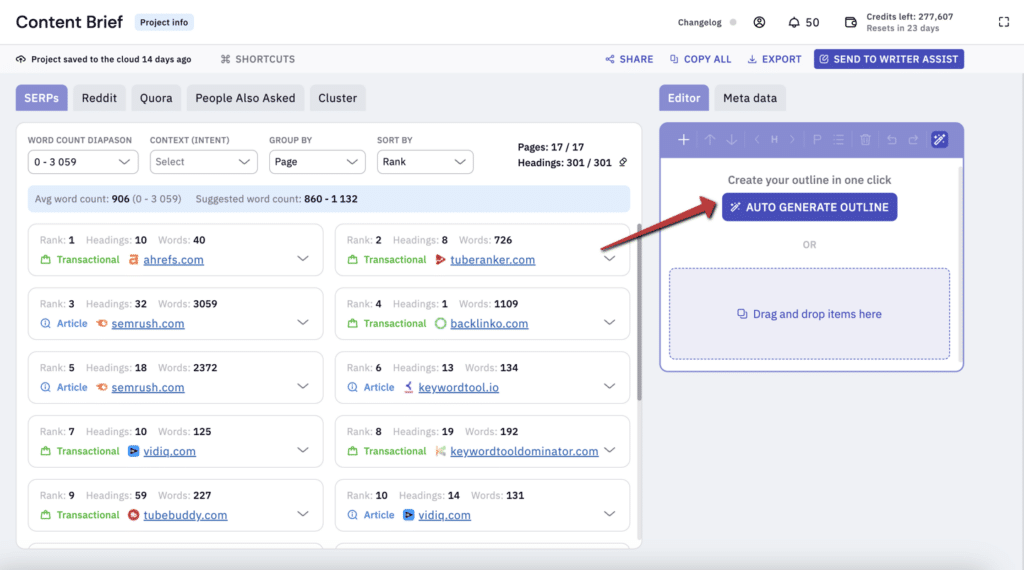
You can then use the AI functionality of our Writing Assistant to quickly turn the outline into a fully written piece.
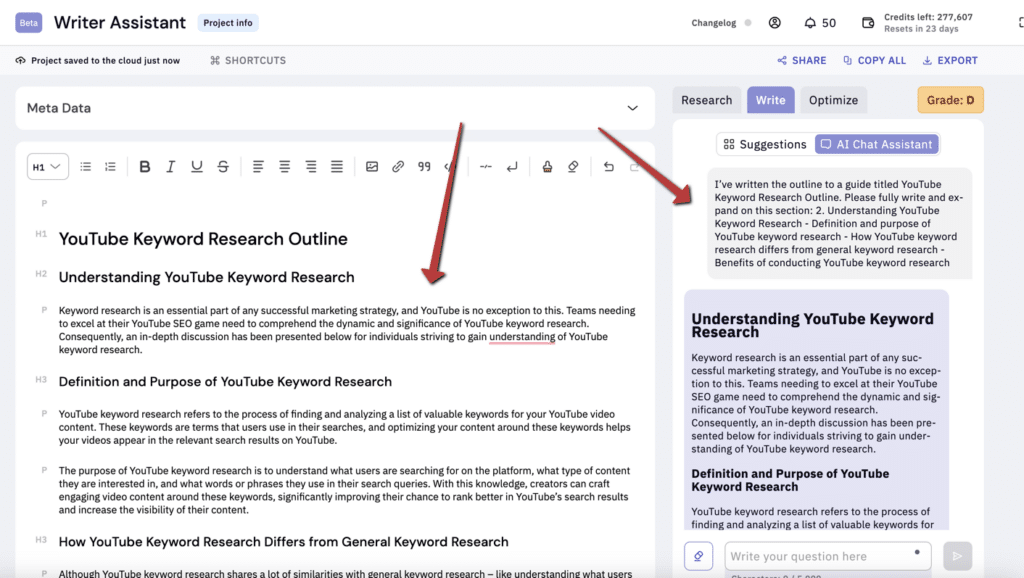
There is also an optimise tab which grades your content in real-time to ensure anything you write is optimised for SEO.
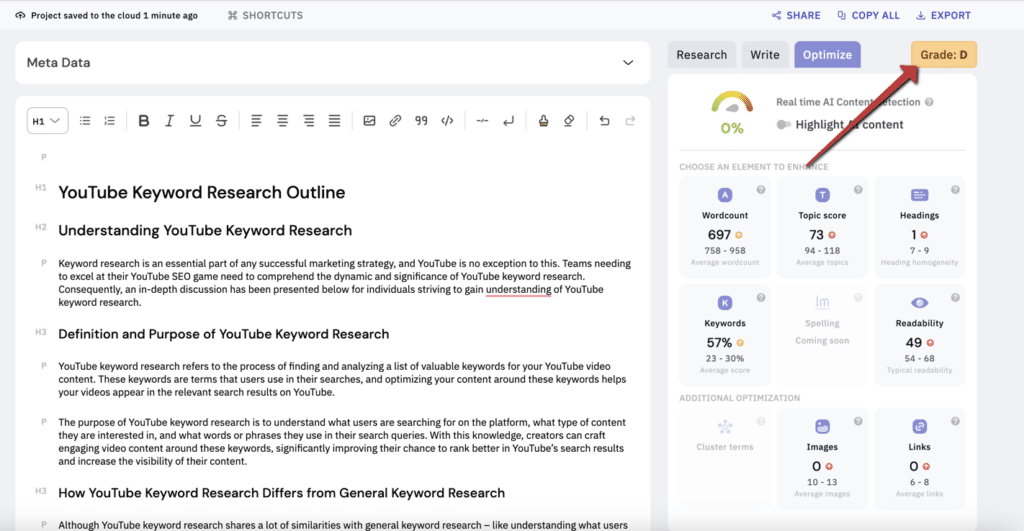
Understanding Topical Clusters vs Keyword Clusters
At times, you may hear the term ‘topical clusters’ used interchangeably or in the same vein as ‘keyword clusters’. While related, there are key distinctions between the two.
As described above, a keyword cluster is a group of similar keywords that have been grouped together. All of these keywords can (and usually should) be targeted on the same page as they mean the same thing or have the same intent.
Introducing Topical Clusters
Topical clusters, by contrast, can be seen as ‘mega clusters’. When we’re organising content on our website, it’s where we’ve thematically grouped and linked similar keyword clusters together. Imagine it as “clustering your clusters” so to speak.
For example, you’ll see in the screenshot below at least 6 “keyword clusters” that are related to doing keyword research for Amazon:
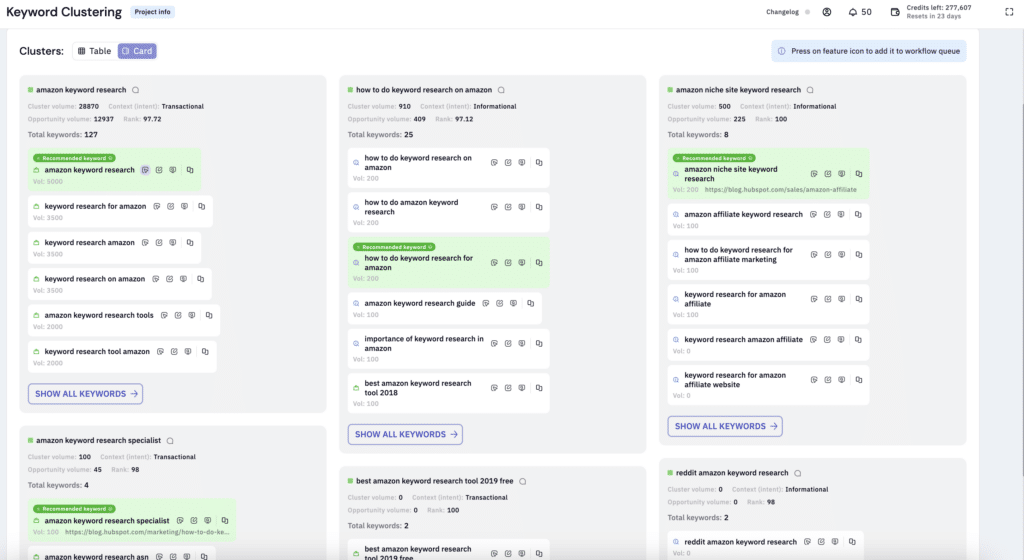
Looking at the clusters, the titles of some of these guides might be:
- How to do keyword research on Amazon
- How to do niche site keyword research for Amazon
- Best Amazon keyword research tools
- How to find a keyword research specialist for Amazon
As is probably obvious, these clusters are very similar; they all have to do with keyword research on Amazon. So by writing these pieces, and interlinking them on our site, we could say we’ve created a “topical cluster” around “Amazon Keyword Research”.
In short, a group of topically related keyword clusters can be grouped to form a “topic cluster”.
Within Keyword Insights we try to make these “topic clusters” easy for you to identify. Utilising the ‘clustering projects’ feature, you can easily find the ‘Topical clusters’ option, which provides a report where we have grouped similar clusters to streamline your content planning process. In the screenshot below, you’ll see all the “Amazon” related clusters grouped within a larger circle.
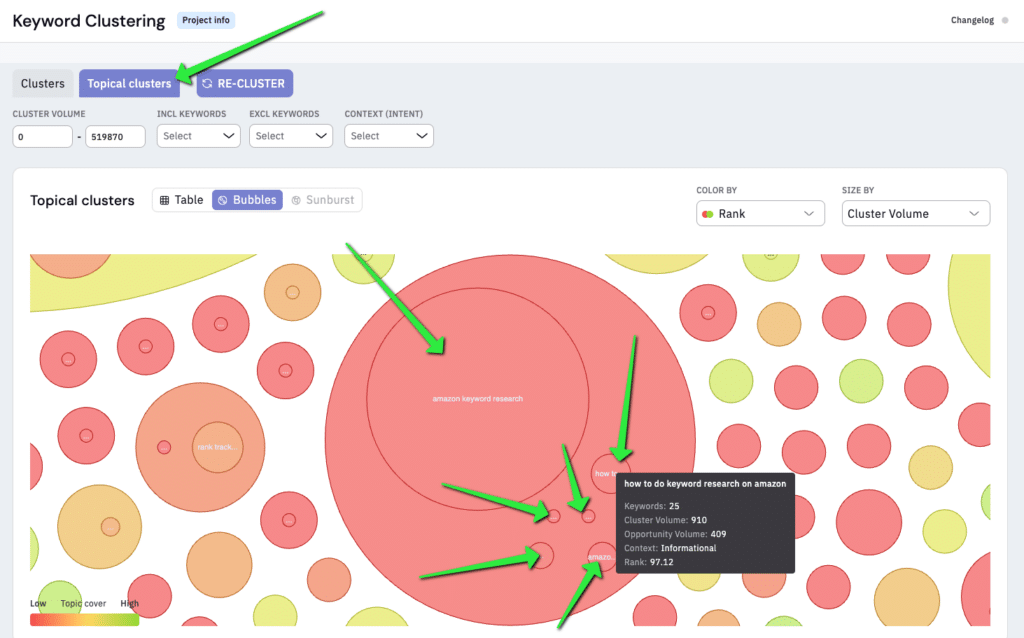
Incidentally, the red ‘circles’ in this report reveal topics our target domain site isn’t currently ranking for, and the size of the circle denotes the search volume. Hence, we also facilitate the discovery of large topical clusters which your current content doesn’t cover.
Components of a Topic Cluster
A topical cluster primarily consists of interlinked webpages (or keyword clusters) all themed around a central topic. It’s usually advised, although not mandatory, to connect all related keyword clusters within a topic via a core ‘pillar’ page. So in the above example, we might have something like the image below.
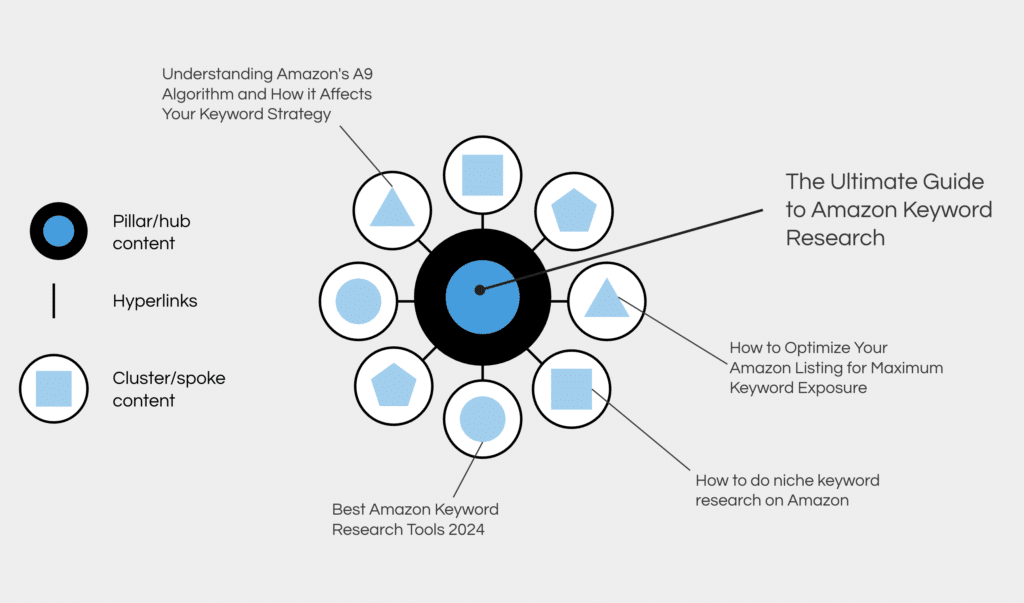
Each “cluster” piece of content is linked to each other where appropriate but also connected via a central “hub” or “pillar” piece of content. In this case “The Ultimate Guide to Amazon Keyword Research” is the pillar piece of content (although please stop writing “Ultimate Guides”. Read this post here for more on that). We’ve also written a more detailed guide on topic clusters here.
What is a Pillar Page?
The ‘pillar’ page offers a wide-ranging overview of the primary topic and provides links to the connected ‘cluster’ pages. Each cluster page, in turn, offers a deeper dive into a specific facet of the main topic and links back to the pillar page. This interconnection helps create a comprehensive and navigable network of content around a particular topic.
So, “Creating topical clusters” essentially describes a systematic approach to planning, drafting, and linking thematically related content on your website. It effectively allows you to thoroughly cover a topic, ensuring a comprehensive and interconnected content framework which facilitates the passing of page rank between important pages.
It’s worth noting, that many people often refer to this way of planning and grouping content as the “hub and spoke” method of content production. Where the hub is the pillar, and the spokes are the keyword clusters.
Advanced Keyword Clustering Techniques and Strategies + Case Studies
In the walkthrough provided above, we illustrated the process of using the Keyword Insights clustering tool to upload thousands of keywords effortlessly. By selecting a few filters, you can easily discover your content gaps by choosing to show only the clusters of keywords where a target domain does not rank. Furthermore, we explained how utilizing the “topic cluster” report allows for the quick grouping of keyword clusters. This simplifies the planning and writing of your content into “topical hubs,” ensuring your site becomes an authority on a given topic.
Our experience with keyword clustering has been transformative, allowing us to meticulously plan, craft, and publish extensive topic clusters that establish our website as a credible authority for search engines, thereby boosting our rankings. A prime example of our success is showcased at the beginning of this guide, where we detail how we increased Latham’s Steel Doors’ traffic by an impressive 1,200%.
However, there are some amazing alternative uses for keyword clustering you might not have thought about.
Using Keyword Clustering to Solve Content Cannibalization
Content cannibalization refers to the problematic scenario where multiple pages on your website end up competing against each other in search engine rankings for the same or similar keywords. This internal competition can diminish the effectiveness and visibility of your web pages, essentially causing them to undermine each other’s performance. Often overlooked, content cannibalization is a critical issue that can severely impact a site’s SEO and overall performance.
This phenomenon is particularly common in large websites, such as those belonging to e-commerce, travel, or real estate sectors, where there’s a tendency to create multiple pages with similar content, either intentionally or accidentally. It can also arise in environments with multiple content creators, such as websites with several writers or in franchise operations, where there’s no centralized content strategy. The lack of coordination and strategy can lead to the creation of content that competes rather than complements each other.
A strategic approach to mitigating content cannibalization involves the use of keyword clustering to identify and resolve overlaps, ensuring that each page targets a unique set of keywords.
We’ve developed two comprehensive case studies/guides that illustrate how you can leverage keyword clustering to detect and address issues of keyword cannibalisation on your website.
Case Study 1 – Best for large e-commerce/travel/property sites
Case Study 2 – Best for editorial-type sites/large blogs
We’d recommend reading both for some great inspiration though.
Using Keyword Clustering to Find Content Ideas Your Competitors Aren’t Writing About
Although keyword clustering is widely discussed, it seems most people are using it in a very standard way—much like the process we described earlier. They gravitate towards the same keyword research tools, input a seed keyword, download the findings, and then cluster these keywords. As a result, their content production strategies are remarkably similar, all focusing on identical topic clusters.
Well, we’ve been using keyword clustering to find content ideas differently.
Reddit + Keyword Clustering
One method is by combining Reddit with keyword clustering.
Reddit offers a unique advantage in keyword research by providing access to a wide, engaged community, making it possible to uncover niche keyword opportunities that competitors might miss. By identifying common questions and topics on Reddit, marketers can find keyword variations and clusters with significant collective search demand. Tools like Keyword Insights can help analyze these keywords’ volume and frequency, facilitating the generation of content ideas tailored to target audience interests. Leveraging Reddit for these insights, combined with AI-driven content creation, enables the production of optimized content that meets specific user needs, giving marketers an edge in SEO and content marketing.
Read the guide to doing keyword research on Reddit here or visit our FREE tool specially made to pull and cluster Reddit questions here.
Of course, you don’t just have to use Reddit, you could do this with any USG forum.
Search Console + Keyword Clustering
Uncover new content ideas by using Search Console to find underperforming keywords with high impressions but low click-through rates, suggesting a gap in targeted content. Enhance this process with Keyword Insights by clustering similar queries to understand their collective impact better.
Read the case study here.
Content Fragmentation
Content fragmentation is a straightforward method for generating new content ideas by dissecting high-ranking search results into more focused articles. The process involves identifying broad topics covered by a top-ranking piece, and then using keyword clustering to break down these topics into narrower, more detailed content pieces. This approach aims to create a series of interconnected articles, each targeting specific aspects of a broader subject, thereby filling content gaps and enhancing SEO performance.
Read the guide on Content fragmentation here.
For other advanced keyword clustering strategies, watch this 45-minute presentation we recently did titled “5 Untapped Benefits Of Keyword Clustering 👇
Wrapping Up
Keyword clustering emerges as a transformative strategy in the SEO and content marketing landscape, offering a sophisticated approach to enhance website visibility, user experience, and content relevance. Through the meticulous grouping of semantically or SERP-related keywords, this guide has illuminated the pathway for creating dense, informative content clusters that resonate with both search engines and audiences alike. Whether leveraging semantic clustering with NLP tools or delving into the nuances of SERP clustering, the techniques outlined provide a comprehensive framework for amplifying your site’s organic reach.
Embracing keyword clustering not only simplifies the content creation process but also elevates the structure and authority of your website, ensuring a robust presence in the digital realm. With practical insights and step-by-step guidance, this guide stands as a beacon for those aiming to master the art of keyword clustering, ultimately driving unprecedented traffic and engagement.
Start your trial today for only $1
Sign up today for a $1 trial and enjoy access to 6000 keyword clustering credits, 3 Keyword discovery searches, 1 Content Brief and Pro versions of SERP Similarity, SERP Explorer.
Subscribe to our newsletter
Subscribe to get our latest news, offers, insights, and any updates.

